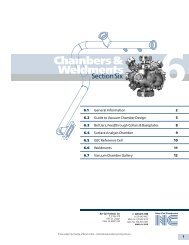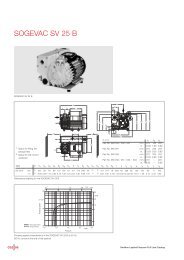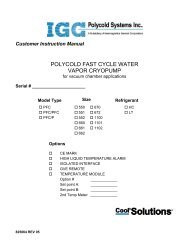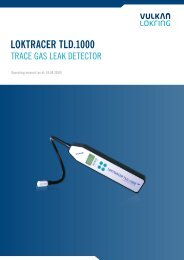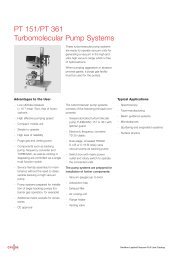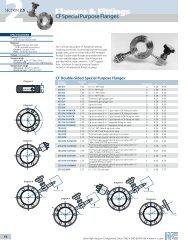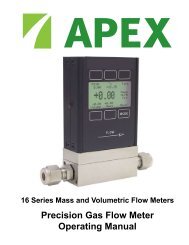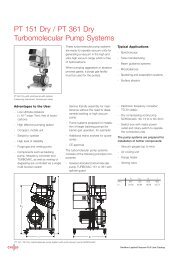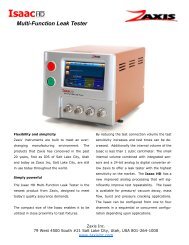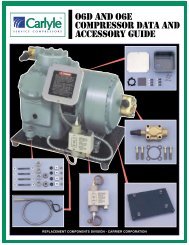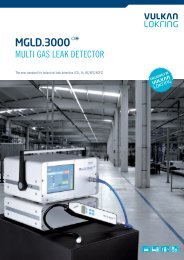INFICON CATALOG 2000-2001 - Schoonover, Inc.
INFICON CATALOG 2000-2001 - Schoonover, Inc.
INFICON CATALOG 2000-2001 - Schoonover, Inc.
Create successful ePaper yourself
Turn your PDF publications into a flip-book with our unique Google optimized e-Paper software.
B6<br />
Vacuum Gauges<br />
Vacuum Gauges and Control Instruments
Vacuum Gauges<br />
Contents<br />
General<br />
Basic Terms of Vacuum Metrology . . . . . . . . . . . . . . . . . . . . . . . . . . . . . . . . . . . . . . . . . . . . . . . B6.3<br />
Transmitter Technology . . . . . . . . . . . . . . . . . . . . . . . . . . . . . . . . . . . . . . . . . . . . . . . . . . . . . . . B6.4<br />
Measurements Units Conversion Chart . . . . . . . . . . . . . . . . . . . . . . . . . . . . . . . . . . . . . . . . . . . C1.3<br />
Sensors<br />
SKYª Capacitance Diaphragm Gauge. . . . . . . . . . . . . . . . . . . . . . . . . . . . . . . . . . . . . . . . . . . . B6.6<br />
CDG025, CDG045 . . . . . . . . . . . . . . . . . . . . . . . . . . . . . . . . . . . . . . . . . . . . . . . . . . . . . . . . B6.6<br />
CDG045-SD . . . . . . . . . . . . . . . . . . . . . . . . . . . . . . . . . . . . . . . . . . . . . . . . . . . . . . . . . . . . . B6.9<br />
Bayard-Alpert Pirani Gauge BPG400 . . . . . . . . . . . . . . . . . . . . . . . . . . . . . . . . . . . . . . . . . . . . B6.12<br />
Pirani Standard Gauge. . . . . . . . . . . . . . . . . . . . . . . . . . . . . . . . . . . . . . . . . . . . . . . . . . . . . . . B6.15<br />
PSG400, PSG400-S . . . . . . . . . . . . . . . . . . . . . . . . . . . . . . . . . . . . . . . . . . . . . . . . . . . . . . B6.15<br />
PSG100-S, PSG101-S . . . . . . . . . . . . . . . . . . . . . . . . . . . . . . . . . . . . . . . . . . . . . . . . . . . . B6.17<br />
Bayard-Alpert Gauge . . . . . . . . . . . . . . . . . . . . . . . . . . . . . . . . . . . . . . . . . . . . . . . . . . . . . . . . B6.19<br />
BAG100-S, BAG101-S . . . . . . . . . . . . . . . . . . . . . . . . . . . . . . . . . . . . . . . . . . . . . . . . . . . . B6.17<br />
Penning Gauge PEG100 . . . . . . . . . . . . . . . . . . . . . . . . . . . . . . . . . . . . . . . . . . . . . . . . . . . . . B6.22<br />
Controller<br />
Vacuum Gauge Controller VGC103 . . . . . . . . . . . . . . . . . . . . . . . . . . . . . . . . . . . . . . . . . . . . . B6.24<br />
Cables . . . . . . . . . . . . . . . . . . . . . . . . . . . . . . . . . . . . . . . . . . . . . . . . . . . . . . . . . . . . . . . . . . . B6.25<br />
Vacuum Switch<br />
Vacuum Switch VSA100. . . . . . . . . . . . . . . . . . . . . . . . . . . . . . . . . . . . . . . . . . . . . . . . . . . . . . B6.27<br />
Calibration<br />
Calibration Service . . . . . . . . . . . . . . . . . . . . . . . . . . . . . . . . . . . . . . . . . . . . . . . . . . . . . . . . . . B6.28<br />
B6.2
Basic Terms of Vacuum Metrology<br />
Vacuum Gauges<br />
Basic Terms of Vacuum Metrology<br />
Today, the total range of measurable vacuum pressure extends from<br />
atmospheric pressure (about 1000 mbar, 750 Torr) down to 10 -12 mbar<br />
(Torr) Ð over 15 decades. The instruments used for measuring pressure<br />
within this wide range are called vacuum gauges. It is impossible to create<br />
a single vacuum sensor capable of performing quantitative measurements<br />
throughout the entire pressure range. Therefore, a variety of different<br />
vacuum gauges are available, each with its own characteristic<br />
measurement range, commonly extending over several decades.<br />
Note the difference between direct and indirect pressure measurements.<br />
With direct pressure measurements, vacuum gauge readings are<br />
independent of gas type. Vacuum gauges, in which pressure is<br />
determined directly by recording the force acting on the surface of a<br />
diaphragm, are common.<br />
With indirect pressure measurements, pressure is determined as a function<br />
of a pressure-dependent property of the gas (i.e. thermal conductivity or<br />
resulting ion current). These properties not only depend on pressure, but<br />
also on the molar mass of the gases. Therefore, vacuum gauge presssure<br />
readings relying on indirect pressure measurements are gas composition<br />
dependent. These readings usually relate to air or nitrogen as the<br />
measurement gas. Appropriate correction factors must be applied for the<br />
measurement of other gases or vapors.<br />
Vacuum Gauges with Pressure Readings<br />
Independent of the Type of Gas<br />
Capacitance Diaphragm Vacuum Gauges<br />
A capacitance diaphragm gauge has two chambers. One is connected to<br />
the vacuum to be measured; the other holds a certain reference vacuum.<br />
The chambers are separated through a metal coated ceramic or thin metal<br />
membrane. Together with a parallel electrode this membrane functions as a<br />
condensator. When the pressure in one chamber is different from the<br />
pressure in the other chamber the membrane bends and thus changes the<br />
capacitance. The change is registered and converted into a pressure signal,<br />
a voltage proportional to the pressure. This method makes gas type<br />
independent absolute pressure measurement possible. Absolute capacitance<br />
gauges can accurately measure pressures from 10 -5 mbar (Torr) to well above<br />
atmospheric pressure using capacitance gauges having diaphragms of<br />
different thickness. 1)<br />
<strong>INFICON</strong> improvements in materials composition provide more stable and<br />
reliable measurements over an extended period of operation. At the same<br />
time, corrosion resistance is greatly enhanced by using ceramic instead<br />
of metal.<br />
Vacuum Gauges with Pressure Readings<br />
Depending on the Type of Gas<br />
Thermal Conductivity Vacuum Gauges (Pirani)<br />
The energy transfer from a hot wire by a gas can be used to measure the<br />
pressure. The heat is transferred into the gas by molecular collisions with<br />
the wire, i.e. by heat conduction and the rate at which the heat is<br />
transferred depends on the thermal conductivity of the gas.<br />
The heat loss from a wire (typically 5 µm to 20 µm in diameter) can be<br />
determined indirectly with a Wheatstone bridge circuit which both heats the<br />
wire and measures its resistance and therefore its temperature.<br />
A thin metal wire is suspended with at least one side electrically insulated<br />
in the gauge head and is exposed to the gas. Tungsten, nickel, iridium or<br />
platinum may be used for the wire. The wire is electrically heated and the<br />
heat transfer is electronically measured. There are three common operating<br />
methods: constant temperature method, constant voltage bridge, and the<br />
constant current bridge. All these methods indirectly measure the<br />
temperature of the wire by its resistance.<br />
This measurement principle uses the thermal conductivity of gases for<br />
pressure measurements from 10 -4 mbar (Torr) to atmospheric pressure.<br />
<strong>INFICON</strong> improvements in temperature compensation provide stable<br />
pressure readings in spite of large temperature changes, especially when<br />
measuring low pressures.<br />
Ionization Gauges<br />
When the pressure in a vacuum system is below about 10 -4 mbar (Torr),<br />
direct methods of measurement of the pressure by means such as the<br />
deflection of a diaphragm or measurement of bulk gas properties such as<br />
thermal conductivity are no longer readily applicable. Hence, it is necessary<br />
to resort to methods which essentially count the number of gas molecules<br />
present i.e., it is the number density not the pressure which is measured.<br />
One of the most convenient methods to measure the number density is to<br />
use some technique to ionize the gas molecules and then collect the ions.<br />
The resulting ion current is directly related to pressure and a calibration can<br />
be performed. The probability of ionizing a gas molecule will depend on a<br />
variety of factors and hence, the ionization gauge will have different<br />
sensitivity values for different gas species.<br />
B6<br />
1) For p < 1 mbar and T Gauge T Vacuum the linearity of a gauge with a controlled temperature is<br />
influenced by the thermal transpiration (gas type dependent) at the maximum in the same order<br />
of magnitude as the zero point stability. See K. F. Poulter, et al., Vacuum 33, 331 (1983);<br />
W. Jitschin and P. Ršhl, J. Vac. Sci. Technol. A, Vol. 5, No. 3, 1987.<br />
B6.3
Vacuum Gauges<br />
Transmitter Technology<br />
Hot Cathode Ionization Vacuum Gauges<br />
In a hot cathode ionization gauge, the electrons emitted from the surface of<br />
a hot filament are attracted to a highly transparent grid made from very thin<br />
wire and at a positive electrical potential. With the grid so open, there is a<br />
very high probability that the electron will pass right through the grid and<br />
not strike a wire. If the grid is surrounded by a screen at a negative<br />
electrical potential, the electron will be repelled by this screen and be<br />
attracted back to the grid. This process can happen many times before the<br />
electron finally hits the grid and is lost. As a result, very long electron paths<br />
can be achieved in a small volume, increasing the probability of ionizing a<br />
gas molecule. The resulting ions are attracted directly to the collector.<br />
Most hot cathode sensors used are based on this Bayard-Alpert<br />
arrangement of electrodes. With this electrode arrangement it is possible<br />
to make measurements in the pressure range from 10 -10 to 10 -2 mbar (Torr).<br />
Other electrode arrangements permit access to a higher range of pressures<br />
from 10 -10 mbar (Torr) up to 10 -1 mbar (Torr). For measurement of pressures<br />
below 10 -10 mbar (Torr), extractor ionization sensors are employed. In<br />
extractor ionization gauges, ions are focused on a very thin and short ion<br />
detector. Due to the geometry of this system, interfering influences such<br />
as X-ray effects and ion desorption are almost completely eliminated.<br />
The extractor ionization gauge permits pressure measurements in the<br />
range from 10 -12 to 10 -4 mbar (Torr).<br />
<strong>INFICON</strong> improvements in electrode arrangements provide a wider<br />
measurement range combined with excellent repeatability. The Bayard-<br />
Alpert Pirani Combination Gauge further improves the measurement range<br />
in an easy to use package.<br />
Cold Cathode Ionization Vacuum Gauges (Penning)<br />
The cold cathode ionization gauge dispenses with the hot filament and uses<br />
a combination of electric and magnetic fields. If one applies a potential of<br />
a few kilovolts between a parallel plate capacitor in the presence of a gas<br />
pressure of a few mbar (Torr), a glow discharge will result. In the glow<br />
discharge, energetic free electrons interact with neutral molecules to<br />
produce ions and more free electrons. The ions are attracted to the negative<br />
electrode and when they strike it, secondary electrons are created, which<br />
are attracted to the positive electrode. The glow discharge continues as<br />
long as the number of electrons being created is equal to or greater than<br />
the number being removed at the positive electrode.<br />
Transmitter Technology<br />
Transmitters convert an analog input signal (pressure) measurement value<br />
into an analog normed electronic measurement signal, i.e. 0 Ð 10 V.<br />
This measurement signal is typically available as a linear or logarithmic<br />
output signal. The advantages of transmitters over conventional gauges<br />
with a separate signal processing device are:<br />
♦ Sensor and electronics in one compact package<br />
♦ Large cost savings<br />
♦ Direct connection to customer control units<br />
♦ A simple formula to convert the measurement signal into any desired<br />
pressure unit<br />
♦ Clear error messages can be transmitted because of the structured<br />
measurement signals<br />
♦ Digital interfaces (RS 232 C, Profibus, DeviceNetª) allow direct<br />
measurement readings in digital form<br />
♦ Integrated setpoint for direct process control based on<br />
pressure measurement<br />
♦ Measurement signals can be transmitted over greater distances<br />
The <strong>INFICON</strong> transmitter vacuum gauge line provides unparalleled<br />
performance for system manufacturers taking advantage of unique<br />
technologies combined with cost saving potential. The transmitter<br />
technology combines the sensor with the control and evaluation electronics<br />
in one compact package. Several output concepts like 0 Ð 10 V analog<br />
output, digital RS 232 C and fieldbus communications are available.<br />
<strong>INFICON</strong> transmitter technology reduces the costs for vacuum<br />
measurement and system integration to a minimum.<br />
The Penning gauge design employs a ring as the positive electrode<br />
(anode), which is centrally located between two electrically connected,<br />
negatively charged, parallel plates (cathodes). Electrons are attracted to the<br />
plane of the ring. Upon arrival, these electrons pass through the ring, and<br />
continue to oscillate between the two cathode plates. This configuration<br />
lowers the pressure at which a discharge can be sustained by increasing<br />
the electron path length. By introducing a magnetic field this electron path<br />
becomes a spiral, significantly increasing the path length. This further<br />
lowers the pressure at which the discharge can be maintained.<br />
<strong>INFICON</strong> design concepts permit safe and reliable operation of ÒPenningÓ<br />
sensors in the pressure range from 1á10 -9 mbar to 1á10 -2 mbar (Torr).<br />
B6.4
Transmitter Technology<br />
Vacuum Gauges<br />
Conventional Measurement Systems<br />
Conventional vacuum measurement systems consist of separate sensors<br />
and control units. The unconditioned sensor signal has to be transmitted to<br />
the control and evaluation unit which makes the system susceptible to<br />
interferences and therefore requires special shielded cabling. Integration<br />
into vacuum systems is space consuming and usually inconvenient since<br />
the controller outputs are not linear or described completely by one<br />
simple formula and therefore require look-up tables to be integrated into<br />
the software.<br />
Transmitter Based Measurement Systems<br />
Analog Technology<br />
Digital Technology<br />
Digital interfaces (RS 232 C, Profibus DP, DeviceNetª) allow direct<br />
measurement readings in digital form and further enhance the advantages<br />
of transmitter technology. <strong>INFICON</strong> digital transmitters provide control of<br />
processes from one control position.<br />
This allows communication of exact digital information, independent control,<br />
maintenance and diagnostic routines for each connected instrument and<br />
simplifies the connection diagram further.<br />
Measures of control include: monitoring of measurement values, the<br />
automatic zero point adjustment of gauges, reminding the operator of<br />
scheduled maintenance work, warning signals in case of instrument<br />
failure and more.<br />
<strong>INFICON</strong> digital transmitters offer the flexibility and control of network<br />
communications further enhancing system quality and efficiency.<br />
B6<br />
The combination of sensor and electronics in one package simplifies the<br />
connection scheme of vacuum systems and saves valuable space and costs.<br />
The measuring signal is converted into an analog 0 Ð 10 V output signal,<br />
which can be directly converted to a digital signal and evaluated by a PLC or<br />
other control. This eliminates the need for a separate control and display unit.<br />
No look-up table is required anymore since the analog output signal is<br />
described completely by one simple formula. <strong>INFICON</strong> analog transmitters<br />
are the most economic solution for advanced vacuum measurement.<br />
B6.5
Vacuum Gauges<br />
SKY TM Capacitance Diaphragm Gauge<br />
SKY Capacitance Diaphragm Gauge<br />
CDG025, CDG045<br />
The SKY CDG uses an ultrapure aluminum oxide ceramic<br />
diaphragm instead of the traditional metal diaphragms used by<br />
other manufacturers. This ultrapure ceramic diaphragm is virtually<br />
corrosion proof resulting in improved reliability, stability and<br />
extended life time, even under the harshest conditions. SKY CDGs<br />
are used by several leading semiconductor system manufacturers.<br />
Patent pending on sensor and diaphragm<br />
Advantages<br />
♦ Marginal zero drift<br />
♦ Virtually corrosion proof Ð long sensor life results in reduced downtime<br />
thus reducing cost of ownership<br />
♦ Superior accuracy and repeatability over long period of operation<br />
♦ Better long-term and temperature stability<br />
♦ Less sensitive to frequent pressure cycles to atmosphere<br />
♦ Eliminates isolation valve (depending on operation mode)<br />
♦ Less susceptible to particles and process by-products through<br />
protective chamber<br />
♦ Fastest warm up time<br />
♦ Lower cost of investment<br />
♦ Supply with +15 V DC or +24 V DC<br />
Ceramic Diaphragms<br />
The diaphragm is the crucial element of any capacitance diaphragm gauge.<br />
Any alteration of the diaphragmÕs deflection characteristics leads to a<br />
change in the displayed pressure.<br />
The <strong>INFICON</strong> aluminum oxide ceramic (Alumina) diaphragms are especially<br />
designed and manufactured for the purpose of measuring also very low<br />
pressures. Ceramic membranes are produced from ultra pure, fine grained<br />
alumina powder in several sintering steps to achieve a dense, stress free<br />
and tension free diaphragm for the sensors. Several firing processes above<br />
1500 ¡C guarantee a purity of 99.5% or more than 99.9%. With this firing<br />
technique an exceptional uniformity of the material is achieved. Aluminum<br />
oxide ceramic diaphragms change less during operation than commonly<br />
used metal diaphragms. Temperature induced stretching, pressure and<br />
material induced creeping, as well as material alterations via corrosion, are<br />
greatly reduced or even eliminated in ceramic diaphragms. The pressure<br />
reading with ceramic diaphragms is more accurate and repeatable than with<br />
metal diaphragms over an extended period of time.<br />
♦ Drop-in replacement of existing CDGs due to interface compatibility<br />
Typical Applications<br />
♦ Etch, CVD, PVD, and other semiconductor production methods<br />
♦ Chemical process engineering<br />
♦ Reference sensor for monitoring of test instruments in accordance<br />
with DIN/ISO 9000<br />
B6.6
SKY TM Capacitance Diaphragm Gauge<br />
Vacuum Gauges<br />
A) Vacuum connection<br />
Stainless Steel, AlSl316L (18% Cr, 10% Ni, 3% Mo, 69% Fe)<br />
B) Protective chamber<br />
Stainless Steel, AlSl316L (18% Cr, 10% Ni, 3% Mo, 69% Fe)<br />
C) Plasma shield<br />
Stainless Steel, AlSl316L (18% Cr, 10% Ni, 3% Mo, 69% Fe)<br />
D) Metal-ceramic connection<br />
Vacon 70 (28% Ni, 23% Co, 49% Fe)<br />
and Braze, Ti, Ag, Cu<br />
E) Measurement chamber<br />
F) Reference chamber<br />
G) Diaphragm<br />
Al 2<br />
O 3<br />
³ 99.9% for 0.1 Ð 10 Torr<br />
Al 2<br />
O 3<br />
³ 99.5% for 100 Ð 1000 Torr<br />
H) Electrode<br />
Gold<br />
I) Glass ceramic solder<br />
J) Sensor housings<br />
Al 2<br />
O 3<br />
³ 99.5%<br />
Better Mechanical Stability<br />
The construction of the measuring cell is based on a symmetry principle.<br />
The diaphragm is bonded to the lower and upper sensor housing with the<br />
same material under the same process. Unwanted asymmetric tension of<br />
the diaphragm is avoided. Another benefit of such a relatively large bond is<br />
the good thermal contact between the housings and the diaphragm.<br />
Thanks to this construction the sensor has excellent mechanical and thermal<br />
stability. Even frequent pressure changes and overpressures cannot alter<br />
such a cell. The measuring results are consistent and remain excellent over<br />
much longer periods of operation than with metal ones.<br />
Better Temperature Stability<br />
Aluminum oxide ceramic has a significantly lower thermal expansion<br />
coefficient than the metals traditionally used. Conventional CDGs are<br />
constructed of a combination of ceramic parts and a metal diaphragm.<br />
The different thermal expansion of these materials can cause tension on the<br />
diaphragm resulting in a distorted pressure reading. The sensor of a<br />
SKYª CDG consists only of aluminum oxide ceramic. Because of this the<br />
span coefficient of a temperature compensated SKY CDG (CDG025) is<br />
improved over a conventional CDG by a factor of four. That of a temperature<br />
controlled gauge (CDG045) by a factor of two.<br />
High Corrosion Resistance<br />
Aluminum oxide ceramic is highly corrosion resistant. ThatÕs why the<br />
SKY CDGs are particularly useful under corrosive process conditions<br />
and deliver reliable measurement values much longer than conventional<br />
(metal diaphragm) CDGs. Corrosive process gases can impair or<br />
damage metal membranes to the point where accuracy and<br />
repeatability are adversely effected or the gauge ultimately fails.<br />
B6<br />
B6.7
Vacuum Gauges<br />
SKY TM Capacitance Diaphragm Gauge<br />
Technical Data<br />
Measurement range F.S. Torr 1)<br />
Lowest suggested control pressure<br />
Lowest suggested reading<br />
Lowest reading<br />
Accuracy 2)<br />
Torr<br />
Torr<br />
Torr<br />
Resolution<br />
% F.S.<br />
Temperature effects<br />
Zero coefficient<br />
% F.S./¡C<br />
Span coefficient<br />
% of reading/¡C<br />
Temperature<br />
Operation (ambient) ¡C<br />
Bakeout at flange ¡C<br />
Pressure, max. absolute<br />
Output signal (analog)<br />
Supply<br />
Voltage<br />
Operating 3) / heating current<br />
Response time<br />
Electrical connector<br />
Materials exposed to process media<br />
Torr<br />
VDC<br />
VDC<br />
mA<br />
ms<br />
Internal volume cm 3 (inch 3 )<br />
Weight<br />
Protection type<br />
kg<br />
CDG025<br />
CDG045<br />
Temperature Compensated Temperature Controlled 45 °C<br />
1000 100 10 1 1000 100 10 1 0.1<br />
5 5 x 10 -1 5 x 10 -2 5 x 10 -3 5 5 x 10 -1 5 x 10 -2 5 x 10 -3 5 x 10 -4<br />
5 x 10 -1 5 x 10 -2 5 x 10 -3 5 x 10 -4 5 x 10 -1 5 x 10 -2 5 x 10 -3 5 x 10 -4 5 x 10 -5<br />
1 x 10 -1 1 x 10 -2 1 x 10 -3 1 x 10 -4 1 x 10 -1 1 x 10 -2 1 x 10 -3 1 x 10 -4 1 x 10 -5<br />
0.2 0.15<br />
0.0015 0.0015 0.0015 0.0025 0.0015 0.0015 0.0015 0.0025 0.0025<br />
0.005 0.005 0.005 0.015 0.0025 0.0025 0.0025 0.0025 0.005<br />
0.01 0.01<br />
+5 É +50 +15 É +40<br />
+110 +90<br />
3000 <strong>2000</strong> <strong>2000</strong> <strong>2000</strong> 3000 <strong>2000</strong> <strong>2000</strong> <strong>2000</strong> 1000<br />
0 É +10 0 É +10<br />
+15 (±5%) or +24 (±10%) +15 (±5%) or +24 (±10%)<br />
60/- 60/- 220/440 220/670<br />
< 30 < 30 < 30 < 100 < 30 < 30 < 30 < 100 < 100<br />
D sub, 15 pin<br />
aluminum oxide ceramic (Al 2 O 3 ), stainless steel (AISI316L) 4) , Vacon 70 5)<br />
6 (0.36) 7 (0.43)<br />
0.26 0.49<br />
IP 30<br />
Ordering Information<br />
1000 100 10 1 1000 100 10 1 0.1<br />
Vacuum connector<br />
1/2Ó tube<br />
DN 16 ISO-KF<br />
DN 16 CF-R<br />
Swagelok¨ 8 VCR¨, female<br />
Terminal strip connector<br />
1) SKYª Capacitance Diaphragm Gauges are also available calibrated in mbar and Pa<br />
2) Non-linearity, hysteresis, repeatability at 25 ¡C ambient operating temperature without<br />
temperature effects<br />
360-000 361-000 362-000 364-000 360-010 361-010 362-010 364-010 365-010<br />
360-001 361-001 362-001 364-001 360-011 361-011 362-011 364-011 365-011<br />
360-002 361-002 362-002 364-002 360-012 361-012 362-012 364-012 365-012<br />
360-003 361-003 362-003 364-003 360-013 361-013 362-013 364-013 365-013<br />
374-990<br />
3) Typical value at 25 ¡C ambient temperature after reaching operating temperature<br />
4) 18% Cr, 10% Ni, 3% Mo, 69% Fe<br />
5) 28% Ni, 23% Co, 49% Fe<br />
mm (inches)<br />
mm (inches)<br />
B6.8
SKY TM Capacitance Diaphragm Gauge<br />
Vacuum Gauges<br />
SKY Capacitance Diaphragm Gauge<br />
CDG045-SD<br />
The SKY CDG045-SD provides the most powerful technology of<br />
network communications and advanced sensor technology available<br />
in the market.<br />
The SKY CDG045-SD combines the advantages of DeviceNet<br />
network communications with the innovative technology of aluminum<br />
oxide ceramic CDGs. DeviceNet improves system quality, lowers cost<br />
and increases efficiency. It allows communication of exact digital<br />
information, independent control, maintenance and diagnostic routines<br />
for each connected instrument and simplifies the connection diagram.<br />
The SKY CDG045-SD conforms to the ODVA Specifications defined<br />
by the Semiconductor Special Interest Group.<br />
Patent pending on sensor and diaphragm<br />
Advantages<br />
♦ Marginal zero drift<br />
♦ Virtually corrosion proof Ð long sensor life results in reduced downtime<br />
thus reducing cost of ownership<br />
♦ Superior accuracy and repeatability over long period of operation<br />
♦ Better long-term and temperature stability<br />
♦ Less sensitive to frequent pressure cycles to atmosphere<br />
♦ Eliminates isolation valve (depending on operation mode)<br />
♦ Less susceptible to particles and process by-products through<br />
protective chamber<br />
♦ Fastest warm up time<br />
♦ Lower cost of investment<br />
♦ Supply with 11 to 25 V DC<br />
♦ Drop-in replacement of existing CDGs due to interface compatibility<br />
Typical Applications<br />
♦ Etch, CVD, PVD, and other semiconductor production methods<br />
♦ Chemical process engineering<br />
♦ Reference sensor for monitoring of test instruments in accordance<br />
with DIN/ISO 9000<br />
Using the SKY CDG045-SD with Fieldbus interface, processes can be<br />
controlled from one central position. The measures of control include:<br />
monitoring of measurement values, the automatic zero point adjustment<br />
of gauges, reminding the operator of scheduled maintenance work,<br />
warning signals in case of instrument failure and more.<br />
DeviceNet is a Fieldbus protocol with trunkline-dropline configuration<br />
which makes it possible to connect industrial instruments such as sensors,<br />
switches, valves, actuators etc. in a master/slave or peer-to-peer network.<br />
Such networks can connect up to 64 individual knots or instruments per<br />
network segment with one host (such as a PLC or PC). Integrated<br />
instruments can receive orders and requests from the host, execute them<br />
and then send information back as a result. DeviceNet offers the simplicity<br />
of running the signal as well as the power supply through the same<br />
Fieldbus cable. Knots can also be removed from the network without<br />
having to turn them off and without having to disconnect the network.<br />
DeviceNet uses the CAN (Controller Area Network) communications<br />
protocol for data transfer. CAN was originally developed for the automobile<br />
industry for applications such as control of ABS breaking systems and air<br />
bags Ð applications requiring fast response times and high reliability.<br />
The same speed and reliability in data transfer is utilized in the <strong>INFICON</strong><br />
sensors with DeviceNet.<br />
DeviceNet is an open networking standard that follows the DeviceNet<br />
specifications Ð this means that it is manufacturer independent.<br />
<strong>INFICON</strong> sensors adhere to these documented standards and guarantee<br />
real plug and play functionality.<br />
B6<br />
B6.9
Vacuum Gauges<br />
SKY TM Capacitance Diaphragm Gauge<br />
Protocol<br />
Technical Data<br />
Data rate switch<br />
Cable length<br />
125 Kbps m (ft)<br />
250 Kbps m (ft)<br />
500 Kbps m (ft)<br />
MAC ID<br />
Network size<br />
Digital functions<br />
Analog functions<br />
Visual communication indicators<br />
Electrical connector<br />
Specifications<br />
(ODVA Semiconductor Special Interest Group<br />
DeviceNet ODVA Specifications<br />
CDG045-SD<br />
DeviceNetª, group 2 slave only<br />
25 k, 250 k, 500 kBaud and programmable over network<br />
500 (1650)<br />
250 (825)<br />
100 (330)<br />
2 switches (address 00-63) or programmable over network<br />
up to 64 nodes per segment<br />
Read pressure, set 2 interlock relays A + B,<br />
select units: Torr, mbar, Pa, set zero over network (digital only)<br />
analog zero must be set with zero potentiometer,<br />
monitor: heater, gauge status, trip point high and low hysteresis,<br />
save state allows definition of behavior in case of error, detailed alarm and warning information<br />
Pressure monitor analog output 0 Ð 10 V<br />
LED network status (green/red)<br />
LED module status (green/red)<br />
2 LED interlock relays A + B (green/off)<br />
Micro style connector (with power and signal line), 5 pin<br />
DeviceNetª ÒVacuum Gauge Device ProfileÓ<br />
Interface Guidelines for DeviceNetª Devices on Semiconductor Manufacturing Tools<br />
Interface Guidelines Conformance Test Procedures<br />
Device type<br />
DeviceNet<br />
Explicit peer to peer messaging<br />
I/O peer to peer messaging<br />
Configuration consistency value<br />
Faulted node recovery<br />
Baud rates<br />
k Baud<br />
Master/Scanner<br />
I/O slave messaging<br />
Bit Strobe<br />
Polling<br />
Cyclic<br />
Change of State (COS)<br />
Interlock relays<br />
Range<br />
Relay contact<br />
Hysteresis<br />
Contact rating<br />
V / A DC<br />
Relay status<br />
Connector<br />
Supply for DeviceNetª and sensor together V DC<br />
Connectors for DeviceNetª<br />
for CDG, analog output and Interlock relay<br />
DeviceNet<br />
CDG045-SD<br />
generic<br />
no<br />
no<br />
no<br />
no<br />
125<br />
250<br />
500<br />
no<br />
no<br />
yes<br />
yes<br />
yes<br />
2<br />
1 x 10 -4 x F.S. É F.S.<br />
n.o., potential free<br />
adjustable over complete range<br />
60 / 0.5<br />
LED green<br />
D sub, 15 pin<br />
11 É 25<br />
Microstyle, 5 pin<br />
D sub, 15 pin<br />
B6.10
SKY TM Capacitance Diaphragm Gauge<br />
Vacuum Gauges<br />
Technical Data<br />
Measurement range F.S. Torr 1)<br />
Lowest suggested control pressure<br />
Torr<br />
Lowest suggested reading<br />
Torr<br />
Lowest reading<br />
Torr<br />
Accuracy 2)<br />
Resolution<br />
% F.S.<br />
Temperature effects<br />
Zero coefficient<br />
% F.S./¡C<br />
Span coefficient<br />
% of reading/¡C<br />
Temperature<br />
Operation (ambient) ¡C<br />
Bakeout at flange ¡C<br />
Pressure, max. absolute<br />
Torr<br />
Output signal (analog)<br />
V<br />
Supply<br />
Voltage<br />
V DC<br />
Operating 3) / heating current<br />
mA<br />
Response time<br />
ms<br />
Electrical connector<br />
Materials exposed to process media<br />
Internal volume cm 3 (inch 3 )<br />
Weight<br />
kg<br />
Protection type<br />
CDG045-SD<br />
Temperature Controlled 45 °C<br />
1000 100 10 1 0.1<br />
5 5 x 10 -1 5 x 10 -2 5 x 10 -3 5 x 10 -4<br />
5 x 10 -1 5 x 10 -2 5 x 10 -3 5 x 10 -4 5 x 10 -5<br />
1 x 10 -1 1 x 10 -2 1 x 10 -3 1 x 10 -4 1 x 10 -5<br />
0.15<br />
0.0015 0.0015 0.0015 0.0025 0.0025<br />
0.0025 0.0025 0.0025 0.0025 0.005<br />
0.01<br />
+15 É +40<br />
+90<br />
3000 <strong>2000</strong> <strong>2000</strong> <strong>2000</strong> 1000<br />
0 É +10<br />
11 - 25<br />
220/450<br />
< 30 < 30 < 30 < 100 < 100<br />
D sub, 15 pin<br />
aluminum oxide ceramic (Al 2 O 3 ), stainless steel (AISI316L) 4) , Vacon 70 5)<br />
7 (0.43)<br />
0.49<br />
IP30<br />
With DeviceNetª<br />
Swagelok¨ 8 VCR¨, female<br />
other flanges available on request<br />
Ordering Information<br />
1) SKYª Capacitance Diaphragm Gauges are also available calibrated in mbar and Pa<br />
2) Non-linearity, hysteresis, repeatability at 25 ¡C ambient operating temperature without<br />
temperature effects<br />
3) Typical value at 25 ¡C ambient temperature after reaching operating temperature at<br />
24 V DC supply<br />
4) 18% Cr, 10% Ni, 3% Mo, 69% Fe<br />
5) 28% Ni, 23% Co, 49% Fe<br />
1000 100 10 1 0.1<br />
360-303 361-303 362-303 364-303 365-303<br />
B6<br />
mm (inches)<br />
B6.11
Vacuum Gauges<br />
Bayard-Alpert Pirani Gauge BPG400<br />
Bayard-Alpert Pirani Gauge BPG400<br />
This outstanding Bayard-Alpert Pirani Combination Gauge<br />
(optional: with display) provides the functions of two gauges in a<br />
single compact unit measuring from atmosphere to 5 x 10 -10 mbar<br />
(3.8 x 10 -10 Torr). This reduces the complexity of installation, setup,<br />
and use of vacuum measurement on the system. The integrated<br />
Pirani protects the hot ion filament from burning out and reduces<br />
the contamination by automatically switching it off at high pressures.<br />
The optional integrated LCD display offers pressure reading and<br />
status information. The BPG400 provides the best performance<br />
for process and base pressure measurement in the most<br />
economic package.<br />
Patent granted on electronics Ð Patent pending on sensor<br />
Advantages<br />
♦ Extremely wide measurement range from 5 x 10 -10 mbar<br />
(3.8 x 10 -10 Torr) to atmosphere combined with excellent repeatability<br />
in the process pressure range (less than ±5%)<br />
♦ Long-life yttrium oxide coated iridium cathode<br />
♦ Robust, compact construction<br />
♦ Easy integration:<br />
Ð one formula produces a logarithmic analog output over entire<br />
pressure range<br />
Ð no interlock with other gauges is necessary<br />
Ð RS 232 C interface<br />
♦ Cost savings:<br />
Ð single gauge instead of two<br />
Ð single flange connection to the system<br />
Ð single cable<br />
♦ Single flange connection reduces probability of leaks<br />
♦ Easy use:<br />
Ð automatic high vacuum adjustment of Pirani through hot ion gauge<br />
Ð optional integrated LCD display for pressure reading and<br />
information status<br />
Ð optional bakeout extension<br />
Typical Applications<br />
♦ Pressure measurement in semiconductor processes and<br />
transfer chambers<br />
♦ Industrial coating (PVD)<br />
♦ General vacuum measurement and control on systems in rough to<br />
high vacuum range<br />
Advantages of BPG400 Over<br />
Conventional Technology<br />
Conventional hot ion gauges used for high vacuum measurement can only<br />
be operated below atmospheric pressures typically in the range below<br />
10 -2 mbar (Torr). When operated at higher pressures the filament lifetime is<br />
dramatically reduced and may burn out almost immediately. Therefore, hot<br />
ion gauges must be switched on only at specified operating pressures.<br />
Usually, a fore vacuum gauge (Pirani) controls the switching on and off of<br />
the hot ion gauge. Such systems consist of two gauges with the necessary<br />
tubing, cabling and corresponding costly signal processing, which is done<br />
by PLC software or hardwiring.<br />
♦ High reliability:<br />
Ð Pirani protects filament from burn out<br />
(withstands air inrush > 10,000 times)<br />
Ð In the unlikely case of failure the sensor can be easily replaced<br />
B6.12
Bayard-Alpert Pirani Gauge BPG400<br />
Vacuum Gauges<br />
Advanced BPG400<br />
The unique concept of the Bayard-Alpert Pirani Combination Gauge<br />
eliminates the disadvantages of conventional technology and provides<br />
unparalleled performance. The gauge consists of two sensing systems, a<br />
hot ion sensor and a Pirani sensor, which signals are combined in one<br />
single compact package.<br />
The enclosed sensor tube with integrated grid protects the sensor from<br />
external electrical fields. The optional baffle is recommended in case of<br />
particles or process by-products possibly contaminating the sensor or when<br />
freak ions, stray light or fast electrons could influence the measurement.<br />
<br />
The Pirani sensor automatically controls the switching on and off of the hot<br />
ion sensor at a defined switching threshold. The filament therefore is<br />
protected since the hot ion sensor is switched off instantaneously in case of<br />
an air inrush. This minimizes problems associated with operator error,<br />
extended signal processing time, and other system failures.<br />
The electron bombardment degas function provides efficient cleaning of a<br />
contaminated sensor. These measures as well as the yttrium oxide coated<br />
iridium filament extend the lifetime of the gauge to its best. When the end<br />
of the sensorÕs lifetime is reached, simply unplug the sensing element from<br />
the electronics and plug in the replacement.<br />
For higher bakeout temperatures the electronics can be easily removed<br />
when no reading is required or the bakeout extension can be attached<br />
between the sensor and the electronics when a reading is required.<br />
B6<br />
Withstands air inrush > 10,000 times.<br />
The BPG400 eases the integration into process systems and reduces cost.<br />
The combination gauge eliminates the need of two single gauges, which<br />
saves one gauge, one port, one cable, tubing, flanging and converter parts.<br />
The software integration is very easy and convenient since the output<br />
signal is described by a simple formula, which reduces cost further.<br />
B6.13
Vacuum Gauges<br />
Bayard-Alpert Pirani Gauge BPG400<br />
Technical Data<br />
BPG400<br />
Measurement range<br />
mbar<br />
Torr<br />
5 x 10 -10 É 1000<br />
3.8 x 10 -10 É 750<br />
Accuracy, 10 -8 É 10 -2 mbar<br />
% of reading<br />
±15%<br />
Repeatability, 10 -8 É 10 -2 mbar<br />
% of reading<br />
±5%<br />
Degas 1) (p < 7.2 x 10 -6 mbar (5.4 x 10 -6 Torr))<br />
electron bombardment,<br />
3 min max.<br />
Pressure, max. absolute<br />
bar<br />
2<br />
Temperature<br />
Operation (ambient) ¡C<br />
Storage ¡C<br />
Bakeout ¡C<br />
At flange with extension ¡C<br />
At flange without extension ¡C<br />
Electronics removed ¡C<br />
0 É +50<br />
-20 É +70<br />
150<br />
80<br />
150<br />
Power supply<br />
Voltage<br />
Consumption, max.<br />
V DC<br />
W<br />
20 É 28<br />
16<br />
Output signal analog<br />
Measurement range, logarithmic<br />
Relation voltage/pressure<br />
Error signal<br />
Minimum load<br />
V<br />
V<br />
V/decade<br />
V<br />
k½<br />
0 É 10<br />
0.774 É 10<br />
0.75<br />
< 0.4<br />
10<br />
optional: display for<br />
pressure and status<br />
information<br />
Interface (digital)<br />
RS 232 C<br />
Connector<br />
Cable length, max. 2)<br />
m (ft)<br />
D sub, 15 pin<br />
100 (330)<br />
mm (inches)<br />
Materials exposed to process media<br />
yttrium oxide, iridium,<br />
stainless steel, Cu, W,<br />
glass, NiFe, NiCr<br />
Internal volume KF / CF cm 3 (inch 3 )<br />
24 / 34 (1.46 / 2.1)<br />
Weight KF / CF<br />
g<br />
285 / 550<br />
Protection type<br />
IP 30<br />
Ordering Information<br />
BPG400<br />
Without LCD display<br />
DN 25 ISO-KF<br />
DN 40 CF-R<br />
353-500<br />
353-502<br />
With LCD display<br />
DN 25 ISO-KF<br />
DN 40 CF-R<br />
353-501<br />
353-503<br />
Replacement sensor<br />
DN 25 ISO-KF<br />
DN 40 CF-R<br />
354-490<br />
354-491<br />
Bakeout extension, 100 mm (3.94 inches)<br />
353-510<br />
24 V DC supply / RS 232 C line<br />
353-511<br />
Baffle<br />
353-512<br />
1) Reduced accuracy during degas<br />
2) RS 232 C operation < 30 m<br />
B6.14
Pirani Standard Gauge<br />
Vacuum Gauges<br />
Pirani Standard Gauge<br />
PSG400, PSG400-S<br />
The Pirani Standard Gauge PSG400 represents the most advanced<br />
Pirani technology in a very compact, rugged package. The improved<br />
temperature compensation by the incorporated twin Pirani provides<br />
faster, more stable vacuum measurement and eliminates the slow<br />
response towards atmospheric pressures. The rugged stainless steel<br />
sensor cell qualifies it for use on semiconductor systems, as well as<br />
traditional applications such as fore vacuum lines.<br />
Patent granted on electronics<br />
Advantages<br />
♦ Small footprint<br />
♦ Mount in any orientation<br />
♦ Metal sealed feedthrough with stainless steel measuring cell<br />
♦ Optimized temperature compensation with twin Pirani principle<br />
♦ Logarithmic signal output for easy integration<br />
♦ High overpressure capability to 10 bar absolute with<br />
threaded connections<br />
♦ Bakeable version available for 250 ¡C at flange<br />
♦ Sensor cell easily replaced<br />
Typical Applications<br />
♦ Controlling of high vacuum ionization gauges<br />
♦ Fore vacuum pressure monitoring<br />
♦ Safety circuits in vacuum systems<br />
♦ General vacuum measurement and control in fine and rough<br />
vacuum range<br />
Advantages of PSG400 Over<br />
Conventional Technology<br />
In conventional Pirani gauges the filament used as measurement element is<br />
one arm of a self-adjusting bridge circuit. The filament temperature is in the<br />
range of 120 ¡C. Whenever a pressure change occurs a gain control<br />
amplifier automatically adjusts the bridge voltage to keep the filament<br />
temperature constant. This bridge excitation is the primary measurement<br />
used in determining the pressure. The ambient operating temperature also<br />
has an influence on the power necessary to keep the filament temperature<br />
constant. Ambient temperature changes appear as changes in pressure.<br />
To compensate, a temperature sensitive element is placed close to the<br />
sensor. The ambient temperature is thus registered and the measurement<br />
signal is compensated, accordingly.<br />
Advanced PSG400<br />
This sensor consists of two filaments, which are kept constant at two<br />
separate operating temperatures (65 ¡C and 120 ¡C). A change in pressure<br />
affects both filaments the same way. The power required to keep the<br />
filaments at the constant temperature is pressure dependent. By using the<br />
power difference between the two filaments one can easily eliminate<br />
changes in the temperature and thus isolate the changes in pressure.<br />
This satisfies the need for temperature compensation, but eliminates the<br />
delays associated with using a separate temperature sensor, resulting in<br />
a very fast response time.<br />
B6<br />
B6.15
Vacuum Gauges<br />
Pirani Standard Gauge<br />
Technical Data<br />
PSG400 PSG400-S<br />
Measurement range<br />
Accuracy, 1 x 10 -2 É 100 mbar<br />
Repeatability, 1 x 10 -3 É 100 mbar<br />
Mounting orientation<br />
Setpoint<br />
Range<br />
Relay contact<br />
Hysteresis<br />
Contact rating<br />
Relay status<br />
mbar<br />
Torr<br />
% of reading<br />
% of reading<br />
mbar<br />
V / A DC<br />
Pressure, max. absolute<br />
bar<br />
Temperature<br />
Operation (ambient) ¡C<br />
Storage ¡C<br />
Bakeout at flange ¡C<br />
Power supply<br />
Voltage<br />
VDC<br />
Consumption, max.<br />
W<br />
Output signal analog<br />
V<br />
Measurement range, logarithmic<br />
V<br />
Relation voltage/pressure<br />
V/decade<br />
Error signal<br />
V<br />
Response time<br />
ms<br />
Connector<br />
Cable length, max.<br />
Materials exposed to process media<br />
m (ft)<br />
Internal volume KF / CF cm 3 (inch 3 )<br />
Weight KF / CF<br />
Protection type<br />
g<br />
5 x 10 -4 É 1000<br />
3.8 x 10 -4 É 750<br />
Å ±10<br />
Å ±2<br />
any<br />
n/a 1<br />
2 x 10 -3 É 500<br />
n.o.<br />
potential free<br />
approx. 30%<br />
of adjusted<br />
pressure<br />
60 / 0.5<br />
LED, green<br />
10 1)<br />
+ 5 É + 60<br />
- 20 É + 65<br />
80 / 250 2)<br />
14 É 32<br />
1<br />
0 É 10.3<br />
1.9 Ð 10<br />
1.286<br />
< 0.5<br />
10<br />
FCC 68, 8 pin (shielded)<br />
100 (330)<br />
tungsten, stainless steel,<br />
glass, Cu, NiFe, Ni<br />
2 / 10 (0.1 / 0.6)<br />
97 / 120<br />
IP 40<br />
mm (inches)<br />
Ordering Information<br />
PSG400<br />
PSG400-S<br />
DN 16 ISO-KF<br />
1/8Ó NPT<br />
DN 16 CF-R 2)<br />
1/2" tube<br />
Swagelok¨ 8 VCR¨, female<br />
Replacement sensor<br />
DN 16 ISO-KF<br />
1/8Ó NPT<br />
DN 16 CF-R 2)<br />
1/2Ó tube<br />
Swagelok¨ 8 VCR¨, female<br />
350-000 350-010<br />
350-001 350-011<br />
350-002 350-012<br />
350-003 350-013<br />
350-004 350-014<br />
350-990<br />
350-991<br />
350-992<br />
350-993<br />
350-994<br />
1) Threaded connections only 2) Extended tube for bakeout with 250 ¡C at flange<br />
B6.16
Pirani Standard Gauge<br />
Vacuum Gauges<br />
Pirani Standard Gauge<br />
PSG100-S, PSG101-S<br />
The Pirani Standard Gauges PSG100-S and PSG101-S are<br />
especially designed for easy integration into vacuum systems using<br />
Profibus DP or DeviceNetª fieldbus protocols. The gauges are<br />
equipped with a set point and for corrosive applications, a platinum<br />
filament version is available.<br />
Patent pending<br />
Advantages<br />
♦ Fieldbus interface (Profibus, DeviceNet) for easy integration into vacuum<br />
systems using network communications<br />
♦ For corrosive applications or high levels of water vapors the PSG101-S<br />
uses a platinum filament and a Al 2<br />
O 3<br />
ceramic feedthrough<br />
♦ Setpoint with adjustable threshold over a wide range<br />
♦ Mount in any position<br />
♦ Logarithmic analog output signal available<br />
♦ Sensor cell is easily replaced<br />
Typical Applications<br />
♦ Processes with corrosive gases (PSG101-S)<br />
♦ Fore vacuum pressure monitoring<br />
♦ Controlling of high vacuum ionization gauges<br />
♦ Safety circuits in vacuum systems<br />
♦ General vacuum measurement and control in the fine and rough<br />
vacuum range<br />
Fieldbus<br />
Fieldbus allows processes or applications the flexibility and control of<br />
network communications. It permits communication of exact digital<br />
information, independent control, maintenance and diagnostic routines<br />
for each connected instrument and simplifies your connection diagram.<br />
The measures of control include: monitoring of measurement values,<br />
automatic zero point adjustment of gauges, update operator of scheduled<br />
maintenance work, warning signals in case of instrument failure, and more.<br />
Profibus DP<br />
The central automation systems, e.g. PLC/PC or process control systems,<br />
communicate through a fast serial connection with decentralized<br />
instruments such as I/O, motors, valves and pressure transmitters. The<br />
exchange of data with the decentralized instruments takes place mostly in<br />
cycles. The basic functions of the Profibus DP Communication Profile also<br />
include acyclic communication services for parameter setting, controlling,<br />
monitoring, and alert functions of intelligent instruments.<br />
DeviceNet<br />
The DeviceNet interface supports polling, bit strobe and change of<br />
state/cyclic commands. Like with other DeviceNet instruments the user<br />
can monitor and control all available sensor functions.<br />
B6<br />
B6.17
Vacuum Gauges<br />
Pirani Standard Gauge<br />
Profibus DP<br />
PSG100-SP<br />
PSG101-SP<br />
Technical Data<br />
PSG100-S<br />
PSG101-S<br />
Supported baud rates (for auto detection)<br />
Expanded user parameter data<br />
Configuring<br />
Number of input and output data<br />
Sync-Mode and Freeze-Mode<br />
Connector<br />
Device type<br />
Explicit Peer to Peer Messaging<br />
I/O Peer to Peer Messaging<br />
Configuration consistency value<br />
Faulted node recovery<br />
Baud rates<br />
Master/Scanner<br />
I/O Slave Messaging<br />
Bit Strobe<br />
Polling<br />
Cyclic<br />
Change of State (COS)<br />
Supply<br />
Connector<br />
DeviceNet<br />
k Baud<br />
Bytes<br />
Bytes<br />
k Baud<br />
V DC<br />
9.6<br />
19.2<br />
93.75<br />
187.5<br />
500<br />
1500<br />
5<br />
2<br />
yes<br />
D sub, 9 pin<br />
PSG100-SD<br />
PSG101-SD<br />
generic<br />
no<br />
no<br />
no<br />
no<br />
125<br />
250<br />
500<br />
no<br />
yes<br />
yes<br />
yes<br />
yes<br />
11 É 25<br />
Phoenix Combicon, 5 pin<br />
Measurement range<br />
Filament material<br />
Mounting position<br />
Fieldbus protocol<br />
Setpoint<br />
Range<br />
Relay contact<br />
Hysteresis<br />
Contact rating<br />
Relay status<br />
Pressure, max. absolute<br />
mbar<br />
Torr<br />
mbar<br />
V / A DC<br />
bar<br />
Temperature<br />
Operation (ambient) ¡C<br />
Storage ¡C<br />
Bakeout at flange ¡C<br />
Power supply<br />
Voltage<br />
V DC<br />
Consumption, max.<br />
W<br />
Output signal analog<br />
V<br />
Measurement range<br />
V<br />
Relation voltage/pressure<br />
V/decade<br />
Connector<br />
Cable length, max. (analog)<br />
Materials exposed to process media<br />
m (ft)<br />
Flange<br />
Internal volume cm 3 (inch 3 )<br />
Weight, approx.<br />
Protection type<br />
kg<br />
5 x 10 -4 É 1000<br />
3.8 x 10 -4 É 750<br />
tungsten platinum<br />
any<br />
DeviceNetª or<br />
Profibus DP<br />
1<br />
1 x 10 -3 É 500<br />
n.o. / potential free<br />
ca. 30% of adjusted pressure<br />
60 / 0.5<br />
LED, green<br />
3 10 1)<br />
+10 É +50<br />
-20 É +70<br />
80<br />
14.5 É 36<br />
< 2<br />
0 É 10.6<br />
0.66 É 10<br />
1.333<br />
FCC 68, 8 pin (shielded)<br />
100 (330)<br />
tungsten, Al, platinum,<br />
nickel-plated stainl. steel,<br />
steel, stainless CrNi, Al 2 O 3<br />
steel, NiFe, ceramics,<br />
glass, NiFe, Mo, Ni<br />
CrNi8020,<br />
epoxy cement<br />
DN 16 ISO-KF<br />
11 (0.67)<br />
0.29<br />
IP 40<br />
Ordering Information<br />
PSG100-S<br />
PSG101-S<br />
With setpoint<br />
With DeviceNetª (PSG100-SD, PSG101-SD)<br />
With Profibus DP (PSG100-SP, PSG101-SP)<br />
Replacement sensor<br />
n/a 350-030<br />
350-021 350-031<br />
350-022 350-032<br />
350-980 350-981<br />
1) Threaded connections only<br />
mm (inches)<br />
B6.18
Bayard-Alpert Gauge<br />
Vacuum Gauges<br />
Bayard-Alpert Gauge<br />
BAG100-S, BAG101-S<br />
The Bayard-Alpert Gauge BAG100S covers an extremely wide<br />
measurement range with excellent reproducibility in the process<br />
pressure range. The sensor employs two filaments which are made<br />
of long-life yttrium oxide coated iridium for standard applications or<br />
alternatively tungsten, which is more compatible with halogens<br />
(Cl, Fl, Br) or hydrogen gas compositions. The gauge features<br />
selectable analog as well as digital communications by RS 232 C<br />
interface or fieldbus options like Profibus DP and DeviceNet.<br />
The IP54 rating ensures protection against dust, water spray, and<br />
electromagnetic interferences.<br />
Advantages<br />
♦ Wide measurement range of 2 x 10 -10 to 1 x 10 -1 mbar<br />
(1.5 x 10 -10 to 7.5 x 10 -2 Torr) with a single sensor<br />
♦ High reproducibility of ±10% of the measurement value within the<br />
process pressure range<br />
♦ Fully encapsulated sensor with a very stable electrode geometry<br />
♦ Longer life through dual cathodesÐautomatic switchover in case of failure<br />
♦ Long-life iridium cathodes with yttrium oxide coating<br />
♦ Continuous measurement available during electron bombardment degas<br />
♦ Easy-to-exchange sensors with automatic self-adjustment to<br />
maintain reproducibility<br />
♦ Relay contact switching threshold adjustable over a wide range<br />
♦ Analog output with selectable logarithmic / linear characteristic<br />
♦ Digital interfaces: RS 232 C / Fieldbus: Profibus DP or DeviceNetª<br />
♦ Rugged IP 54 metal enclosure<br />
♦ High EMI compatibility through screened enclosure, screened sensor,<br />
and interference suppression on all inputs and outputs<br />
Typical Applications<br />
♦ Pressure measurement in semiconductor processes and<br />
transfer chambers<br />
♦ Evaporation and coating systems<br />
♦ General pressure measurement and control in fine and high vacuum range<br />
The innovative Bayard-Alpert Transmitters BAG100-S and BAG101-S offer<br />
a wide measurement range spanning from 2 x 10 -10 to 1 x 10 -1 mbar.<br />
The wide range Bayard-Alpert measuring system is mechanically protected<br />
by the metal tube which surrounds it. The rugged arrangement of the<br />
electrodes ensures highly repeatable measurements over the entire range.<br />
Each sensor is individually calibrated in the factory. The calibration data<br />
are stored in an EEPROM which is fully integrated into the sensor.<br />
When exchanging the sensor, the electronics of the transmitter are<br />
automatically adjusted to the currently connected sensor so that the<br />
specified reproducibility can be guaranteed. The sensor with a CF flange<br />
is equipped with a welded current feedthrough which enables degassing<br />
of the sensor at a temperature of 150 ¡C with the electronics in place.<br />
Sensor supply and processing of the measurement data is performed by<br />
microprocessor controlled electronics which require a 24 V power supply<br />
and draw a very low current. The microcontroller also controls the<br />
BAG100-S and BAG101-S in that it monitors the emission, converts and<br />
corrects the measurement data (automatic correction of the sensorÕs<br />
sensitivity, matching of the unit etc.) and monitors the trigger thresholds<br />
for the relay.<br />
The selectable signal output characteristics (linear / logarithmic) as well<br />
as the digital computer interfaces permit easy integration in existing or<br />
future system concepts.<br />
B6<br />
B6.19
Vacuum Gauges<br />
Bayard-Alpert Gauge<br />
Fieldbus<br />
Fieldbus allows processes or applications the flexibility and control of<br />
network communications. It permits communication of exact digital<br />
information, independent control, maintenance and diagnostic routines<br />
for each connected instrument and simplifies your connection diagram.<br />
Device type<br />
DeviceNet<br />
Explicit Peer to Peer Messaging<br />
I/O Peer to Peer Messaging<br />
BAG100-SD<br />
BAG101-SD<br />
generic<br />
no<br />
no<br />
The measures of control include: monitoring of measurement values,<br />
automatic zero point adjustment of gauges, update operator of scheduled<br />
maintenance work, warning signals in case of instrument failure, and more.<br />
Profibus DP<br />
The central automation systems, e.g. PLC/PC or process control systems,<br />
communicate through a fast serial connection with decentralized<br />
instruments such as I/O, motors, valves and pressure transducers.<br />
The exchange of data with the decentralized instruments takes place<br />
mostly in cycles. The basic functions of the Profibus DP Communication<br />
Profile also include acyclic communication services for parameter setting,<br />
controlling, monitoring, and alert functions of intelligent instruments.<br />
Configuration consistency value<br />
Faulted node recovery<br />
Baud rates<br />
Master/Scanner<br />
I/O Slave Messaging<br />
Bit Strobe<br />
Polling<br />
Cyclic<br />
Change of State (COS)<br />
Supply<br />
Connector<br />
k Baud<br />
V DC<br />
no<br />
no<br />
125<br />
250<br />
500<br />
no<br />
yes<br />
yes<br />
yes<br />
yes<br />
11 É 25<br />
Microstyle, 5 pin<br />
DeviceNet<br />
The DeviceNet interface supports polling, bit strobe and change of<br />
state/cyclic commands. Like with other DeviceNet instruments the user<br />
can monitor and control all available sensor functions.<br />
Profibus DP<br />
Supported baud rates (auto detection)<br />
k Baud<br />
BAG100-SP<br />
9.6<br />
19.2<br />
93.75<br />
187.5<br />
500<br />
1500<br />
Expanded user parameter data<br />
no<br />
Configuring<br />
Number of input and output data<br />
Bytes<br />
2 each<br />
Sync-Mode and Freeze-Mode<br />
yes<br />
Connector<br />
D sub, 9 pin<br />
mm (inches)<br />
B6.20
Bayard-Alpert Gauge<br />
Vacuum Gauges<br />
Technical Data<br />
BAG100-S<br />
BAG101-S<br />
Measurement range<br />
Reproducibility<br />
Repeatability<br />
Long term sensitivity drift<br />
Filament material<br />
Number of filaments<br />
Degas (p < 2 x 10 -5 mbar (1.5 x 10 -5 Torr))<br />
mbar<br />
Torr<br />
% of reading<br />
% of reading<br />
% of reading<br />
Setpoint<br />
Range<br />
mbar<br />
Relay contact<br />
Hysteresis<br />
Contact rating<br />
V / A DC<br />
Relay status<br />
Pressure, max. absolute<br />
bar<br />
Temperature<br />
Operation (ambient) ¡C<br />
Storage ¡C<br />
Bakeout at flange DN 25 ISO-KF ¡C<br />
Bakeout at flange DN 40 CF-R ¡C<br />
Power supply<br />
Voltage<br />
VDC<br />
Current Consumption<br />
Operation<br />
A<br />
Bakeout<br />
A<br />
Measurement start (approx. 1 sec.)<br />
A<br />
Output signal analog<br />
V<br />
Measurement range<br />
V<br />
Selectable scaling<br />
Interface (digital)<br />
Response time (at p > 1 x 10 -6 mbar)<br />
ms<br />
Connector<br />
Cable length, max. (analog)<br />
m (ft)<br />
Materials exposed to process media (excl. filament)<br />
Internal volume, approx. DN 25 KF / DN 40 CF cm 3 (inch 3 )<br />
Weight, approx. DN 25 KF / DN 40 CF<br />
kg<br />
Protection type<br />
2 x 10 -10 É 1 x 10 -1 2 x 10 -10 É 5 x 10 -3<br />
1.5 x 10 -10 É 7.5 x 10 -2 1.5 x 10 -10 É 3.8 x 10 -3<br />
±10<br />
±2<br />
±2<br />
yttrium oxide, iridium<br />
tungsten<br />
2<br />
electron bombardment, 3 min max.<br />
1 1<br />
1 x 10 -9 É 1 x 10 -1 1 x 10 -9 É 1 x 10 -3<br />
n.o. / potential free<br />
n.o. / potential free<br />
approx. 10% of adjusted pressure approx. 10% of adjusted pressure<br />
60 / 0.5 60 / 0.5<br />
LED, green<br />
LED, green<br />
2<br />
0 É +50<br />
-20 É +70<br />
80<br />
150<br />
20 É 28<br />
0.5<br />
0.8<br />
1.4<br />
0 É 10<br />
0 É 10<br />
1 or 3 decades out of 9<br />
RS 232 C<br />
100<br />
D sub, 15 pin (shielded)<br />
100 (330)<br />
stainless steel, glass, NiFe, NiCr<br />
24 / 34 (1.46 / 2.1)<br />
0.98 / 1.28<br />
IP 54<br />
B6<br />
Ordering Information<br />
BAG100-S<br />
BAG101-S<br />
DN 25 ISO-KF<br />
DN 40 CF-R<br />
With Profibus DP (BAG100-SP)<br />
DN 25 ISO-KF<br />
DN 40 CF-R<br />
With DeviceNetª (BAG100-SD, BAG101-SD)<br />
DN 25 ISO-KF<br />
DN 40 CF-R<br />
Replacement sensor<br />
DN 25 ISO-KF<br />
DN 40 CF-R<br />
24 V DC supply / RS 232 C line<br />
352-000 n/a<br />
352-002 352-003<br />
352-010 n/a<br />
352-011 n/a<br />
352-005 352-007<br />
352-006 352-008<br />
352-490 352-492<br />
352-491 352-493<br />
353-511<br />
B6.21
Vacuum Gauges<br />
Penning Gauge PEG100<br />
Penning Gauge PEG100<br />
The Penning Gauge PEG100 provides reliable high vacuum<br />
measurements. The rugged penning cold cathode sensor has no<br />
filament to burn out. Due to titanium cathode plates and the reduced<br />
high voltage after plasma ignition, the gauge can be operated also in<br />
sputtering applications. The fieldbus options, in addition to the<br />
logarithmic analog output signal, allow easy integration into vacuum<br />
systems using Profibus DP or DeviceNet protocols.<br />
Patent pending on sensor<br />
Advantages<br />
♦ Wide measurement range from 1 x 10 -9 to 1 x 10 -2 mbar (7.5 x 10 -10<br />
to 7.5 x 10 -3 Torr)<br />
♦ All-metal cold cathode sensor (Penning) with ceramic feedthrough<br />
♦ New electrode geometry provides excellent ignition properties<br />
♦ Decreased high voltage after plasma ignition and titanium cathode<br />
plates reduce risk of contamination, even during sputtering operations<br />
with argon<br />
♦ The anode ring and the titanium cathode can be cleaned or<br />
replaced easily<br />
♦ Minimal magnetic field intensity adjacent to gauge<br />
♦ LED indicator for power on and plasma ignited<br />
♦ Logarithmic analog output signal<br />
♦ Fieldbus interface (Profibus DP, DeviceNet) for easy integration into<br />
vacuum systems using network communications<br />
Typical Applications<br />
♦ High vacuum pressure monitoring<br />
♦ Evaporation and sputtering systems<br />
♦ General vacuum measurement and control in the fine and high<br />
vacuum range<br />
The Penning Gauge PEG100 is a cold cathode sensor based on the well<br />
proven principle of Penning. For degassing of the all-metal sensor with<br />
Al 2<br />
O 3<br />
current feedthrough, the housing of the transmitter with its electronics<br />
and magnet may easily be removed. The magnet offers a closed magnetic<br />
field for negligible stray field. The PEG therefore may also be installed close<br />
to sensitive parts within a system. The anode ring and the titanium cathode<br />
plates may be exchanged easily for quick maintenance should they become<br />
contaminated. Since sputtered titan is not magnetic Ð limiting the build up of<br />
short circuits within the sensor Ð the risk of contamination is greatly<br />
reduced. The newly designed cathode plate acts as a baffle for the sensor.<br />
Fieldbus<br />
Fieldbus allows processes or applications the flexibility and control of<br />
network communications. It permits communication of exact digital<br />
information, independent control, maintenance and diagnostic routines for<br />
each connected instrument and simplifies your connection diagram.<br />
The measures of control include the monitoring of measurement values, the<br />
automatic zero point adjustment of gauges, reminding the operator of<br />
scheduled maintenance work, warning signals in case of instrument failure<br />
and more.<br />
Profibus DP<br />
The central automation systems, e.g. PLC/PC or process control systems,<br />
communicate through a fast serial connection with decentralized<br />
instruments such as I/O, motors, valves and pressure transducers. The<br />
exchange of data with the decentralized instruments takes place mostly in<br />
cycles. The basic functions of the Profibus DP Communication Profile also<br />
include acyclic communication services for parameter setting, controlling,<br />
monitoring, and alert functions of intelligent instruments.<br />
DeviceNet<br />
The DeviceNet interface supports polling, bit strobe and change of<br />
state/cyclic commands. Like with other DeviceNet instruments the user can<br />
monitor and control all available sensor functions.<br />
B6.22
Penning Gauge PEG100<br />
Vacuum Gauges<br />
Profibus DP<br />
PEG100-P<br />
Technical Data<br />
PEG100<br />
Supported baud rates (auto detection)<br />
Expanded user parameter data<br />
Configuring<br />
Number of input and output data<br />
Sync-Mode and Freeze-Mode<br />
k Baud<br />
Bytes<br />
Bytes<br />
9.6<br />
19.2<br />
93.75<br />
187.5<br />
500<br />
1500<br />
5<br />
2<br />
yes<br />
Measurement range<br />
Accuracy, 1 x 10 -8 É 1 x 10 -4 mbar<br />
mbar<br />
Torr<br />
% of reading<br />
Pressure, max. absolute<br />
bar<br />
Temperature<br />
Operation (ambient) ¡C<br />
Storage ¡C<br />
Bakeout<br />
without electronics ¡C<br />
with electronics, at flange ¡C<br />
1 x 10 -9 É 1 x 10 -2<br />
7.5 x 10 -10 É 7.5 x 10 -3<br />
Å ±30<br />
10<br />
+10 É +50<br />
-20 É +75<br />
350<br />
70<br />
Connector<br />
D sub 9 pin<br />
Power supply<br />
Voltage<br />
Consumption, max.<br />
VDC<br />
W<br />
14.5 É 36<br />
< 2<br />
Device type<br />
Explicit Peer to Peer Messaging<br />
I/O Peer to Peer Messaging<br />
Configuration consistency value<br />
Faulted node recovery<br />
Baud rates<br />
DeviceNet<br />
k baud<br />
PEG100-D<br />
generic<br />
no<br />
no<br />
no<br />
no<br />
125<br />
250<br />
500<br />
Output signal analog<br />
Measurement range<br />
Relation voltage/pressure<br />
Connector<br />
Cable length, max. (analog)<br />
Materials exposed to process media<br />
V<br />
V<br />
V/decade<br />
m (ft)<br />
Internal volume cm 3 (inch 3 )<br />
Weight, approx.<br />
kg<br />
Protection type<br />
0 É 10.6<br />
0.66 É 10<br />
1.333<br />
FCC 68, 8 pin (shielded)<br />
100 (330)<br />
stainless steel, CrNi,<br />
Al 2 O 3 , NiFe, Mo, Cu, Ni, Ti<br />
21 (1.28)<br />
0.5<br />
IP 40<br />
Master/Scanner<br />
no<br />
I/O Slave Messaging<br />
Bit Strobe<br />
Polling<br />
Cyclic<br />
Change of State (COS)<br />
Supply<br />
Connector<br />
V DC<br />
yes<br />
yes<br />
yes<br />
yes<br />
11 É 25<br />
Phoenix Combicon, 5 pin<br />
Ordering Information<br />
PEG100<br />
DN 25 ISO-KF<br />
DN 40 CF-R<br />
With DeviceNetª (PEG100-D)<br />
DN 25 ISO-KF<br />
DN 40 CF-R<br />
With Profibus DP (PEG100-P)<br />
DN 25 ISO-KF<br />
Replacement cathode plates, titanium<br />
Set of 5 pieces<br />
PEG100<br />
351-000<br />
351-002<br />
351-003<br />
351-004<br />
351-005<br />
351-490<br />
B6<br />
mm (inches)<br />
B6.23
Vacuum Gauges<br />
Vacuum Gauge Controller VGC103<br />
Vacuum Gauge Controller VGC103<br />
By combining up to three principles of measurement Ð from hot<br />
cathode, cold cathode, Pirani or capacitance diaphragm gauges Ð<br />
the Vacuum Gauge Controller VGC103 covers the entire pressure<br />
range from 10 -10 to <strong>2000</strong> mbar (Torr). Switching over of the display<br />
to the right pressure range is automatic for the most common sensor<br />
combinations. The display of the VGC103 combines the advantages<br />
of analog and digital readouts.<br />
Advantages<br />
♦ Can be combined with up to three sensor types for an extremely wide<br />
measurement range<br />
♦ Full remote control via RS 232 C interface<br />
♦ User selectable measurement unit (millibar, Torr, Pascal or micron)<br />
♦ Analog bar graph display compliments digital readout<br />
♦ Three adjustable setpoints with adjustable hysteresis, may be assigned<br />
to any channel<br />
♦ Programmable 0 É 10 V chart recorder output with logarithmic / linear<br />
characteristics for each gauge or combination of PSG and BAG<br />
♦ Compact bench-top unit which can be installed in panel cut-outs or a<br />
19Ó racks (1/4 19Ó, 3U height)<br />
The VGC103 easily fits your application specifications thanks to the<br />
possibility of combining various sensors with different methods of<br />
measurement and different measurement ranges.<br />
Multiple Recorder Outputs and Control<br />
Signals For Simplified Process Integration<br />
The VGC103 offers standard features that other controllers only offer as<br />
add-on options:<br />
♦ Three adjustable setpoints with adjustable hysteresis and arbitrary<br />
allocation to the three measuring channels<br />
♦ Automatic control of the emission (Bayard-Alpert Gauge BAG) or of high<br />
voltage (Penning Gauge PEG) with Pirani Gauge PSG on channel 2<br />
Easy To Read – Easy To Use<br />
The large digital display allows for easy and quick reading of the<br />
measurement value, while the analog bar graph display allows for at a<br />
glance verification. During pressure measurement the display changes<br />
automatically over to the input channel of the correct sensor for the sensor<br />
combination: Ch 2 = PSG, Ch 3 = BAG. The values can be displayed in<br />
millibar, Torr, Pascal or micron.<br />
With its compact dimensions the VGC (1/4 19Ó, 3U height) easily fits<br />
into panel cutouts or 19Ó racks and can be used just as easily as a<br />
bench top unit.<br />
B6.24
Vacuum Gauge Controller VGC103<br />
Vacuum Gauges<br />
Rear view of the VGC103<br />
B6<br />
Cables<br />
Technical Data<br />
Cable to VGC103 in m (ft)<br />
3 (9.9)<br />
5 (16.5)<br />
10 (33)<br />
15 (49.5)<br />
20 (66)<br />
30 (99)<br />
40 (132)<br />
50 (165)<br />
75 (247.5)<br />
100 (330)<br />
PSG/PEG BPG/BAG CDG<br />
398-500 398-520 398-540<br />
398-501 398-521 398-541<br />
398-502 398-522 398-542<br />
398-503 398-523 398-543<br />
398-504 398-524 398-544<br />
398-505 398-525 398-545<br />
398-506 398-526 n/a<br />
398-507 398-527 n/a<br />
398-508 398-528 n/a<br />
398-509 398-529 n/a<br />
B6.25
Vacuum Gauges<br />
Vacuum Gauge Controller VGC103<br />
Measurement channels<br />
Display<br />
Range<br />
Technical Data<br />
mbar<br />
Torr<br />
Digital<br />
Analog<br />
Switching<br />
Rate 1/s<br />
Connectable transmitters with display range<br />
CDG<br />
Torr<br />
BPG<br />
mbar (Torr)<br />
PSG<br />
mbar (Torr)<br />
PEG<br />
mbar (Torr)<br />
BAG<br />
mbar (Torr)<br />
Measurement unit (selectable)<br />
Type of gas (selectable) Ð BAG only<br />
Setpoints<br />
Adjustment range<br />
Hysteresis<br />
Relay contact<br />
Contact rating<br />
V / A DC<br />
Ready indication relay<br />
Relay contact<br />
Contact rating<br />
V / A DC<br />
Analog output<br />
Channels<br />
Range<br />
Channel 1, 2, 3<br />
Channel 4<br />
Interface (digital)<br />
Connector<br />
Power<br />
Output for setpoint and analog output<br />
Supply<br />
V<br />
Frequency<br />
Hz<br />
Consumption<br />
W<br />
Temperature<br />
Operation (ambient) ¡C<br />
VGC103<br />
3<br />
backlit<br />
2 x 10 -10 É <strong>2000</strong><br />
1.5 x 10 -10 É 1500<br />
LCD, 7-segments<br />
LCD, bargraph<br />
automatic or manual between connected sensors<br />
4<br />
1 x 10 -3 x FS É 1 x FS<br />
5 x 10 -10 É 1000<br />
5 x 10 -4 É 1000<br />
1 x 10 -9 É 1 x 10 -2<br />
2 x 10 -10 É 1 x 10 -1<br />
mbar, Torr, Pascal, micron<br />
Air, Ar, N 2<br />
3 assignable to channel 1, 2 or 3<br />
sensor dependent<br />
adjustable<br />
potential free changeover contact<br />
60 / 0.5<br />
1 assignable to channel 1, 2 or 3<br />
potential free changeover contact<br />
60 / 0.5<br />
4<br />
0 É 10 V<br />
Sensor analog output signal<br />
Output of channel 1, 2, 3 with selectable scaling or combination PSG and BAG<br />
RS 232 C<br />
D sub, 9 pin<br />
D sub, 25 pin<br />
85 É 264<br />
50/60<br />
60<br />
0 É 50<br />
Ordering Information<br />
VGC103<br />
3 channel controller 398-000<br />
mm (inches)<br />
B6.26
Vacuum Switch VSA100<br />
Vacuum Gauges<br />
Vacuum Switch VSA100<br />
The pressure switch VSA100 is used as a safety switch in vacuum<br />
systems. For example, to automatically interrupt the gas supply<br />
when venting vacuum systems with a purge gas at a pressure of<br />
6 mbar below atmospheric pressure.<br />
Advantages<br />
♦ Reliable control of atmospheric pressure during venting<br />
♦ High contact rating and life time<br />
Technical Data<br />
Switching pressure at venting mbar (Torr)<br />
6 (4.5) below<br />
atmospheric pressure<br />
♦ Rugged design<br />
♦ Easy to integrate<br />
♦ IP 44 protection<br />
♦ Can be connected to a programmable control<br />
Switching pressure at pumping<br />
Switching inaccuracy<br />
Max. permissible<br />
operating pressure (absolute)<br />
mbar (Torr)<br />
mbar (Torr)<br />
mbar (Torr)<br />
3 (2.25) below<br />
atmospheric pressure<br />
1 (0.75)<br />
<strong>2000</strong> (1500)<br />
Typical Applications<br />
♦ Control of load lock chambers<br />
♦ Safety shutdown of vacuum systems<br />
Temperature<br />
Operation (ambient) ¡C<br />
Storage ¡C<br />
Switching contact<br />
0 É +85<br />
-25 É +85<br />
Changeover contacts,<br />
gold-plated, for prog. controls<br />
B6<br />
At a differential pressure of 6 mbar below atmospheric pressure an elastic<br />
diaphragm actuates a high current changeover contact which in turn may<br />
be used to directly switch any ancillary equipment. The electrical connection<br />
is concealed by a polymeric cover<br />
Contact life (at 5 A)<br />
Contact rating<br />
Electrical connection<br />
Cable length<br />
V AC / A / VA<br />
m (ft)<br />
> 10 5 switching cycles<br />
220 / 5 / 1100<br />
6.3 mm flat plug<br />
3 (9.9)<br />
Technical Note<br />
Due to the diaphragm material used (EPDM) the Vacuum Switch VSA100 is<br />
not suited for applications in which the process gas contains large quantities<br />
of helium. The leak rate of the diaphragm for helium is > 10 -6 mbar x l x s -1 .<br />
Vacuum connection<br />
Materials exposed to process media<br />
Protection class<br />
DN 16 ISO-KF<br />
stainless steel 1.4305,<br />
EPDM, polyamide with<br />
glass fibre, epoxy cement<br />
IP 44<br />
Ordering Information<br />
DN 16 ISO-KF, complete with 3 m (10 ft) cable<br />
399-000<br />
mm (inches)<br />
B6.27
Vacuum Gauges<br />
Calibration Service<br />
Calibration Service<br />
<strong>INFICON</strong> offers calibration services for vacuum gauges. A DKD calibration<br />
certificate or a factory calibration certificate can be issued. Calibration to<br />
other standards (e.g. NIST) is available upon request.<br />
Advantages<br />
♦ Known deviation to calibration standards<br />
♦ Controlled quality over time<br />
Typical Applications<br />
♦ Reference to standard is required<br />
♦ Reference for customer in-house calibration service of vacuum gauges<br />
DKD Calibration<br />
The German Calibration Service (DKD) ensures traceability of industrial<br />
measurements and testing to national calibration standards. It is run jointly<br />
by the Federal Institution for Physics and Technology (PTB), the Industry,<br />
the Federal Minister for Economics and the Western European Metrology<br />
Club (WEMC).<br />
The transfer standards employed in the DKD calibration facility are checked<br />
regularly (recalibrated) by the PTB.<br />
Factory Calibration<br />
Factory calibrations are run with standards which have not been calibrated<br />
directly at the PTB; instead the transfer standards of the DKD calibration<br />
service are used. Thus traceability to national standards is ensured in<br />
both cases.<br />
Other Calibrations<br />
NIST Calibration available upon request. Call for pricing and availability.<br />
Ordering Information<br />
Calibration range<br />
to 10 -3 mbar/Torr<br />
to 10 -5 mbar/Torr<br />
to 10 -9 mbar/Torr<br />
DKD Calibration<br />
Factory Calibration<br />
398-900 398-910<br />
398-901 398-911<br />
398-902 398-912<br />
B6.28



